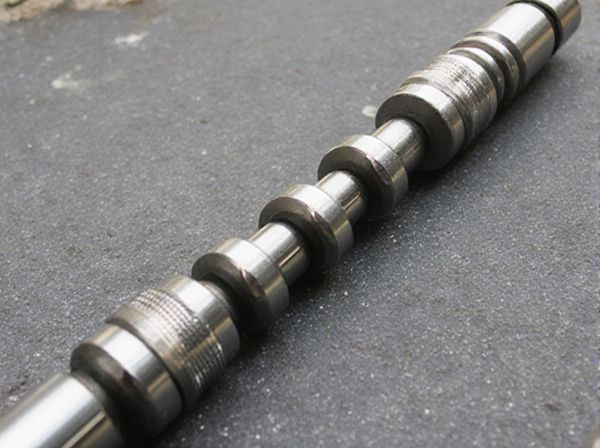
Photo illustration: Steel Driveshaft vs Aluminum Driveshaft
Steel driveshafts offer superior strength and durability, making them ideal for heavy-duty applications where maximum torque and reliability are crucial. Aluminum driveshafts provide a lightweight alternative that enhances vehicle performance by reducing rotational mass and improving acceleration and fuel efficiency. Choosing the right driveshaft depends on your vehicle's needs, balancing strength with weight for optimal driving dynamics.
Table of Comparison
| Feature | Steel Driveshaft | Aluminum Driveshaft |
|---|---|---|
| Weight | Heavier, adds more rotational mass | Lighter, improves vehicle acceleration and fuel efficiency |
| Durability | Highly durable, resists impact and fatigue | Moderate durability, prone to dents and fatigue over time |
| Cost | Lower cost, budget-friendly option | Higher cost, premium pricing |
| Performance | Reliable under heavy loads and high torque | Better performance in weight-sensitive applications |
| Corrosion Resistance | Prone to rust, requires protective coating | Corrosion-resistant, naturally forms oxide layer |
| Maintenance | Requires regular inspection and protective measures | Lower maintenance due to corrosion resistance |
Introduction to Driveshaft Materials
Steel driveshafts offer superior strength and durability, making them ideal for high-torque applications and heavy-duty vehicles. Aluminum driveshafts provide a lightweight alternative that improves vehicle acceleration and fuel efficiency while reducing rotational mass. The choice between steel and aluminum depends on performance requirements, cost considerations, and specific vehicle dynamics.
Steel Driveshaft: Composition and Features
Steel driveshafts consist primarily of carbon steel alloys, known for their exceptional strength and durability. These driveshafts offer high torque capacity and resistance to twisting, making them ideal for heavy-duty and performance applications. Their inherent heaviness provides better vibration dampening but may impact overall vehicle weight and fuel efficiency.
Aluminum Driveshaft: Composition and Features
Aluminum driveshafts are primarily composed of 6061-T6 or 7075-T6 aluminum alloys, offering a lightweight yet high-strength alternative to steel. These shafts feature superior resistance to corrosion and reduced rotational mass, enhancing vehicle acceleration and fuel efficiency. Their design often incorporates a hollow, tubular structure to maximize strength-to-weight ratio and reduce vibrations during high-speed operation.
Weight Comparison: Steel vs Aluminum
Aluminum driveshafts weigh approximately 40-50% less than steel driveshafts, significantly reducing the rotational mass and improving vehicle acceleration and fuel efficiency. Steel driveshafts, although heavier at around 20-30 pounds for typical applications, offer superior strength and durability under high torque conditions. The lightweight nature of aluminum reduces drivetrain inertia, enhancing performance in sports cars and racing vehicles where every pound saved contributes to better handling and responsiveness.
Strength and Durability Differences
Steel driveshafts offer superior strength and durability due to their higher tensile strength and resistance to fatigue, making them ideal for heavy-duty and high-torque applications. Aluminum driveshafts provide weight savings that improve acceleration and fuel efficiency but generally have lower tensile strength and are more prone to fatigue cracks under extreme stress. Choosing between steel and aluminum driveshafts depends on the balance needed between durability requirements and performance benefits.
Performance Impact: Acceleration and Handling
Steel driveshafts provide superior strength and durability, which enhances acceleration by efficiently transferring torque with minimal flex. Aluminum driveshafts offer reduced weight, leading to lower rotational mass and improved handling responsiveness during quick directional changes. The choice between steel and aluminum driveshafts directly affects vehicle dynamics, with steel favoring torque delivery and aluminum optimizing agility.
Maintenance and Longevity
Steel driveshafts require regular lubrication and inspection to prevent rust and ensure long-term durability, making maintenance moderately frequent but straightforward. Aluminum driveshafts, while lighter and resistant to corrosion, may be more prone to fatigue and cracking, necessitating thorough periodic checks to maintain structural integrity. Longevity-wise, steel generally outperforms aluminum under high-stress conditions, offering a longer lifespan with proper upkeep.
Cost Analysis: Initial and Long-Term
Steel driveshafts generally have a lower initial cost compared to aluminum driveshafts, making them a budget-friendly choice for many automotive applications. However, aluminum driveshafts offer long-term savings through reduced weight, which enhances fuel efficiency and decreases wear on drivetrain components. The durability of steel driveshafts often results in lower replacement frequency, while aluminum driveshafts may incur higher maintenance costs due to susceptibility to dents and cracks.
Applications: Best Uses for Steel and Aluminum
Steel driveshafts excel in heavy-duty applications such as trucks, off-road vehicles, and performance cars, offering superior strength and durability under high torque and stress. Aluminum driveshafts are ideal for lightweight vehicles and racing applications where reducing rotational mass enhances acceleration and fuel efficiency. Each material's unique properties make them suited to specific performance demands and vehicle types.
Choosing the Right Driveshaft for Your Vehicle
Steel driveshafts offer superior strength and durability, making them ideal for heavy-duty and off-road vehicles requiring high torque capacity. Aluminum driveshafts are lighter, reducing rotational mass and improving acceleration and fuel efficiency, best suited for performance and street-driven vehicles. Selecting the right driveshaft depends on balancing weight, strength, and vehicle application to optimize driveline performance and longevity.
 caratoz.com
caratoz.com